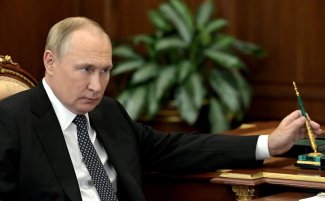Russian attack on US drone. Day 384 of the war

On 14 March, in the early morning hours, an aerial incident involving two Russian Su-27 fighter jets and a US MQ-9 Reaper unmanned combat aerial vehicle (UCAV) occurred 60 km or 120 km (37.5–75 miles) southwest of Sevastopol, depending on sources. The incident was first reported late in the afternoon by Commander of the US Air Force in Europe and Africa, General James B. Hecker. Conducting routine reconnaissance in international airspace, the MQ-9 was said to have been intercepted and then its propeller was struck by a fighter jet. As a result, the unmanned aircraft malfunctioned and the Americans were forced to decide to sink it in international waters.
The Russian defence ministry issued a communiqué citing loss of manoeuvrability as the reason for the sinking of the MQ-9 as a result of the risky manoeuvres carried out by the American machine. The Russians stated that their aircraft did not use armament or make contact with the apparatus, and returned to base after completing the patrol. On 15 March, Russian Ambassador to the United States Anatoly Antonov announced that the drone had ‘violated the boundary of the temporary airspace regime established for the ‘special military operation’ and was moving ‘provocatively’ towards Russian territory.
On the evening of 14 March, Pentagon spokesman Patrick Ryder described the incident as a collision blamed on ‘dangerous and unprofessional behaviour by Russian pilots’. The fighters were said to have initially dropped fuel on the MQ-9 and then clipped the propeller of the US machine as a result of a dangerous approach. Ryder stressed that the Russian aircraft must also have suffered damage. A day later, National Security Council spokesman John Kirby announced that the US was taking action to prevent the Russians from seizing the wreckage of the MQ-9. In doing so, he stressed that no outsiders should have access to it.
Commentary
- Although Washington has accepted the version of a collision between a fighter jet and an unmanned aircraft, statements by US military officials confirm a deliberate effort by the Russians to sink the MQ-9 near Crimea. Described as supermaneuverable aircraft, the Su-27 had no serious problem carrying out this operation with precision, especially in contact with a machine that is relatively slow and structurally unsuited to combat (despite the similar size of the two types). In addition, the Su-27’s reinforced design enables it to ram aerial targets. The Reaper is purely a carrier of reconnaissance and weapons systems, which allows it to be used to attack a variety of targets (it is referred to as a hunter-killer and has been used successfully in Afghanistan), but becomes de facto defenceless when attacked by a typical combat aircraft. It remains an open question whether the Americans are using UCAV category machines for surveillance in the Crimea area, rather than strictly reconnaissance aircraft (e.g. RQ-4 Global Hawk).
- In deciding to attack the US drones, Moscow was most likely guided by two objectives – political and technical-military. In political-propaganda terms, the incident should be seen as an attempt to deter the US from continuing (and increasing) its military support of Ukraine by suggesting an alleged readiness for escalation on the part of Russia, feared by part of the US (and European) establishment. In doing so, Moscow is testing how far it can go without provoking a sharp reaction from Washington. In technical-military terms, the Russian pilots’ task was to enable the acquisition of a relatively complete copy of the unmanned aircraft and, in so doing, to develop methods to counter US airborne reconnaissance measures and to acquire the technology to develop their own analogous designs. Despite Kirby’s declarations, the Americans do not have the capability to prevent Russia from finding and retrieving the wreckage of the MQ-9, and the Russian Black Sea Fleet has the means to carry out such an operation relatively quickly. It is possible that the machine has already ended up in the hands of the Russians, or will be seized by them in the coming days.
- Washington’s restrained response to the incident carries the risk of Russia repeating such moves or even escalating them, including against other states that support Ukraine militarily. This is because Moscow is eager to exploit any reaction to its actions that it sees as a sign of weakness.




